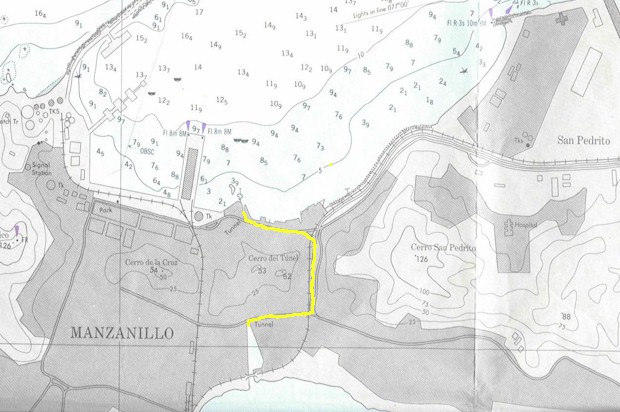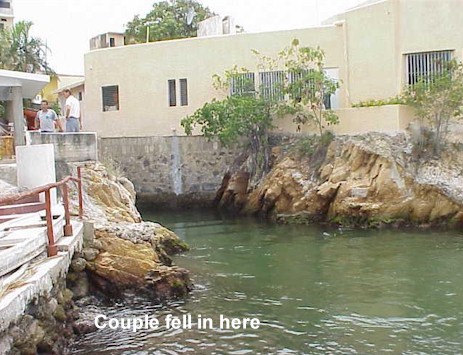
Tunnel of Terror

Several years ago a
young couple was sitting on the edge of a natural rocky shelf jutting out near
the boat dock behind Ly Chee Restaurant. They were clearly in love, hugging and
kissing, and dangling their bare feet in the water.
It
was a hot day and the cool, freshness of the sea was clearly inviting.
Stretching, to immerse a little more of her long, tanned legs into the alluring
depths, the young girl slipped and fell in. The water was not deep; she could
touch the bottom.
But
what she hadn’t counted on was a strong current, for she had fallen in at the
mouth of the tunnel that runs beneath the city of Manzanillo and empties into
the lagoon near the electric power plant.
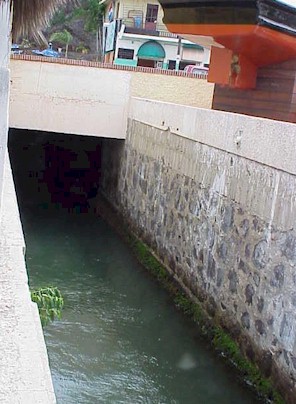 Her
boyfriend, seeing her futile struggles, jumped in to save her. He, too, was
swept away by the powerful current, and they both disappeared into the inky
depths of the tunnel’s foreboding waters.
Her
boyfriend, seeing her futile struggles, jumped in to save her. He, too, was
swept away by the powerful current, and they both disappeared into the inky
depths of the tunnel’s foreboding waters.
Sadly,
a few days later, their lifeless bodies were discovered in the shallow lagoon
near Las Ventanas.
More
recently, on September 21, an International Beach Clean-up sponsored by Project
A.W.A.R.E. (Aquatic World Awareness, Responsibility and Education), 26 divers
entered the water in the La Perlita-San Pedrito area. The day’s goal was to
remove and catalog as much trash as possible to determine the major polluters in
the Manzanillo area.
Almost
every diver in the water had hundreds of hours of diving experience. This was
good, because experience, and knowledge of the ocean and its currents, along
with physical fitness played a part in averting another tragedy at the mouth of
the tunnel.
As
the buddy team of Steve Stanton and Susan Dearing began collecting their second
bag of trash for the day, they became aware of a mild current. Within less that
a minute, the current doubled, then tripled in strength. It took only a moment
to realize they were being swept, like the young couple, into the tunnel. PADI
Instructor Susan Dearing began grabbing onto coral-encrusted rocks to pull them
to safety. Holding onto Steve with one hand, and inching along a handhold at a
time, they were finally able to exit the tunnel and secure a firm grip on a
rocky point.
It
was tough going, because with each attempt to get a handhold, the soft coral,
which has been building up for years, would break off. Steve, without gloves,
could only help by swimming as strongly as he could to help reduce drag. Though
the dive team only had to swim about 7 meters, it seemed tantamount to climbing
the Volcan de Colima with a 100-lb. pack.
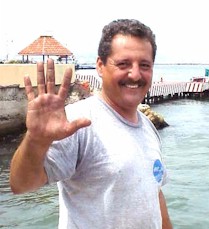 Once
at the surface and clinging to the rocks (Steve was still holding on to the bag of
trash!), they were assisted across the mouth of the tunnel by Gerardo Montes,
who appeared in a tiny dingy. Montes is the captain of the fishing boat “Esqualo,”
and has lived in Manzanillo for many years.
Once
at the surface and clinging to the rocks (Steve was still holding on to the bag of
trash!), they were assisted across the mouth of the tunnel by Gerardo Montes,
who appeared in a tiny dingy. Montes is the captain of the fishing boat “Esqualo,”
and has lived in Manzanillo for many years.
According
to Gerardo, he has helped in numerous rescues
at the tunnel, and has also seen his share of tunnel-related drownings, such as
the heartbreaking story told here of the young lovers’ tragic end.
 Throughout
our life, God gives all of us challenges, and He delivers messages in many ways.
This time God chose His messengers well. By allowing seasoned divers to
experience the danger of the strong current at high tide, He gave the new
ecological foundation, BUCEAA (Buzos Unidos Conservando El Ambiente Acuatico) its
first mission: to install a safety net across the both ends of the tunnel.
Throughout
our life, God gives all of us challenges, and He delivers messages in many ways.
This time God chose His messengers well. By allowing seasoned divers to
experience the danger of the strong current at high tide, He gave the new
ecological foundation, BUCEAA (Buzos Unidos Conservando El Ambiente Acuatico) its
first mission: to install a safety net across the both ends of the tunnel.
 According
to Susan Dearing, co-director of BUCEAA, the estimated cost of 2 durable
half-inch diameter polypropylene rope nets, securely anchored above and beneath the
surface, is only $500.
According
to Susan Dearing, co-director of BUCEAA, the estimated cost of 2 durable
half-inch diameter polypropylene rope nets, securely anchored above and beneath the
surface, is only $500.
The net’s mesh will be wide enough to allow
small fish to
pass, but will prevent endangered sea turtles from getting pulled into the
tunnel and trapped in debris. Anyone who falls in by accident, or swimmers
who are caught in a tide change, will be able to pull themselves across to
safety. It will be anchored at the bottom so that divers never get near enough to the tunnel
to get caught in the currents.
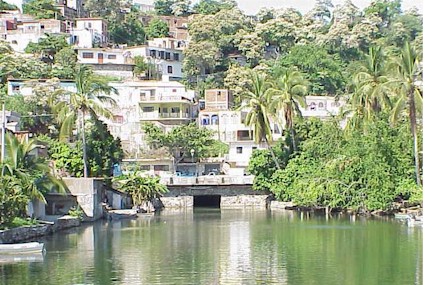 The
photo to the right shows the other end of the tunnel, which opens into the
lagoon. Many homes surround this area, most with small children. At low tide,
the current runs from this side, back into the ocean. Refer to the map at the
end of this article to see the u-shaped maze of the tunnel that runs underneath
the city of Manzanillo.
The
photo to the right shows the other end of the tunnel, which opens into the
lagoon. Many homes surround this area, most with small children. At low tide,
the current runs from this side, back into the ocean. Refer to the map at the
end of this article to see the u-shaped maze of the tunnel that runs underneath
the city of Manzanillo.
If 500
people would give only 10 pesos or one dollar each, Manzanillo’s tunnel could
have a safety net guaranteed to last 25 years, and no more lives of citizens or
animals would be lost.
To help, contact BUCEAA@yahoo.com
for more information, or call Carlos Cuellar, general director of BUCEAA,
at 044-314-358-0327 (cellular) or 333-0642 (office).
